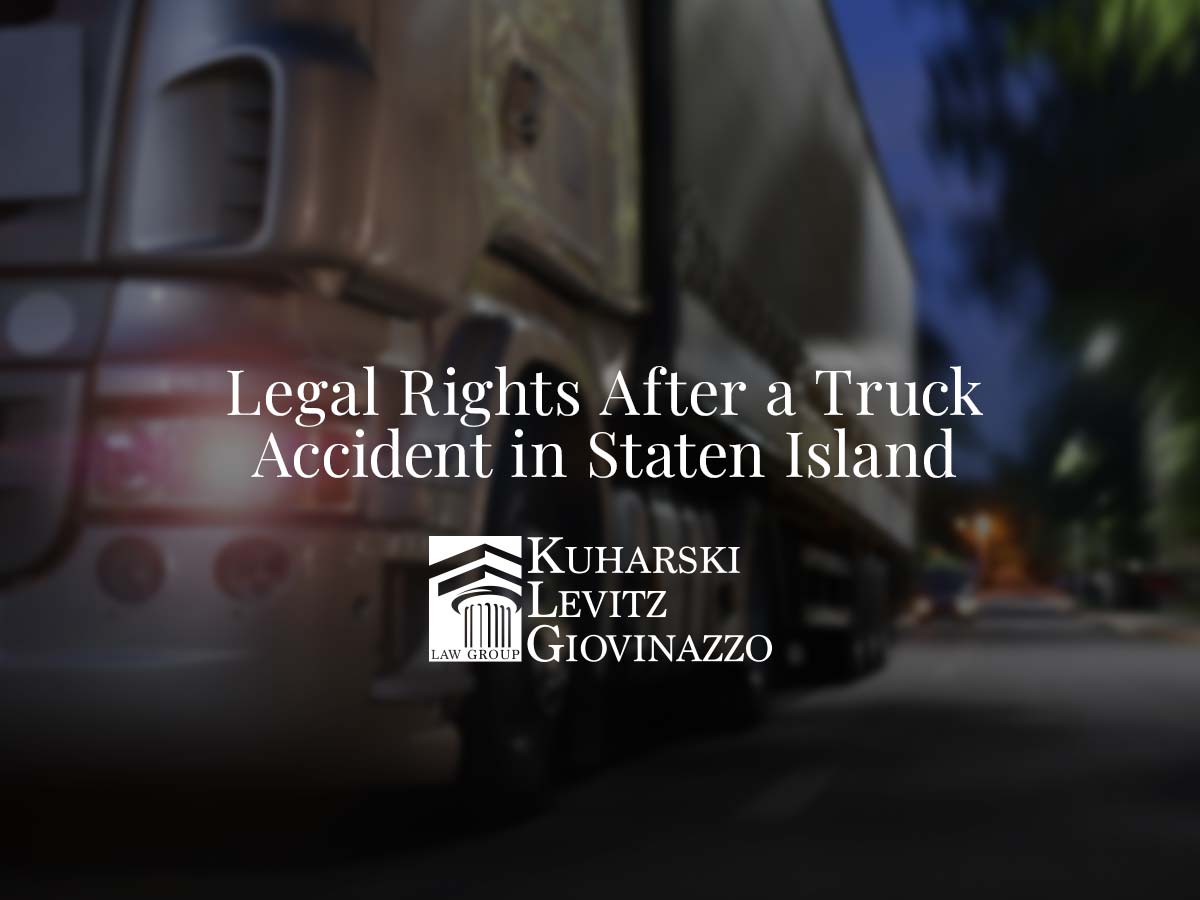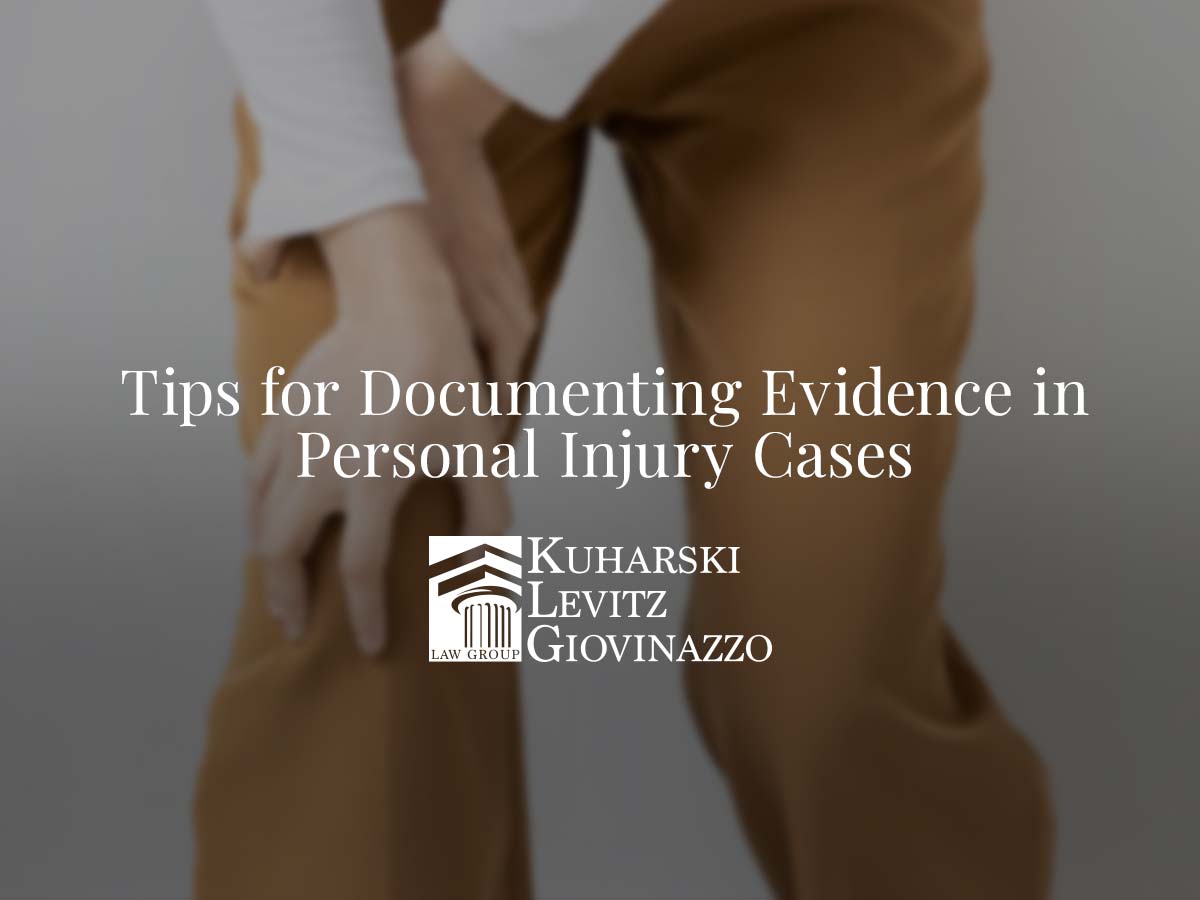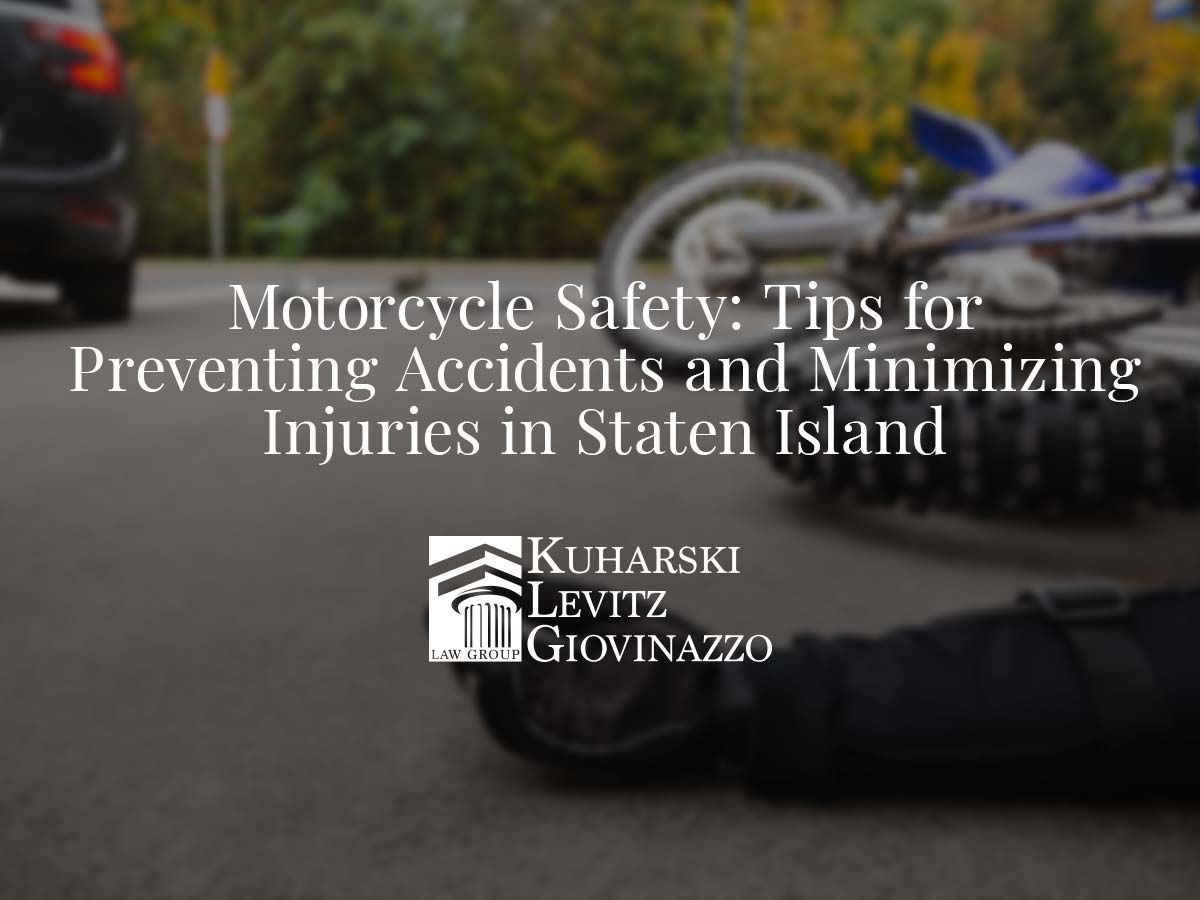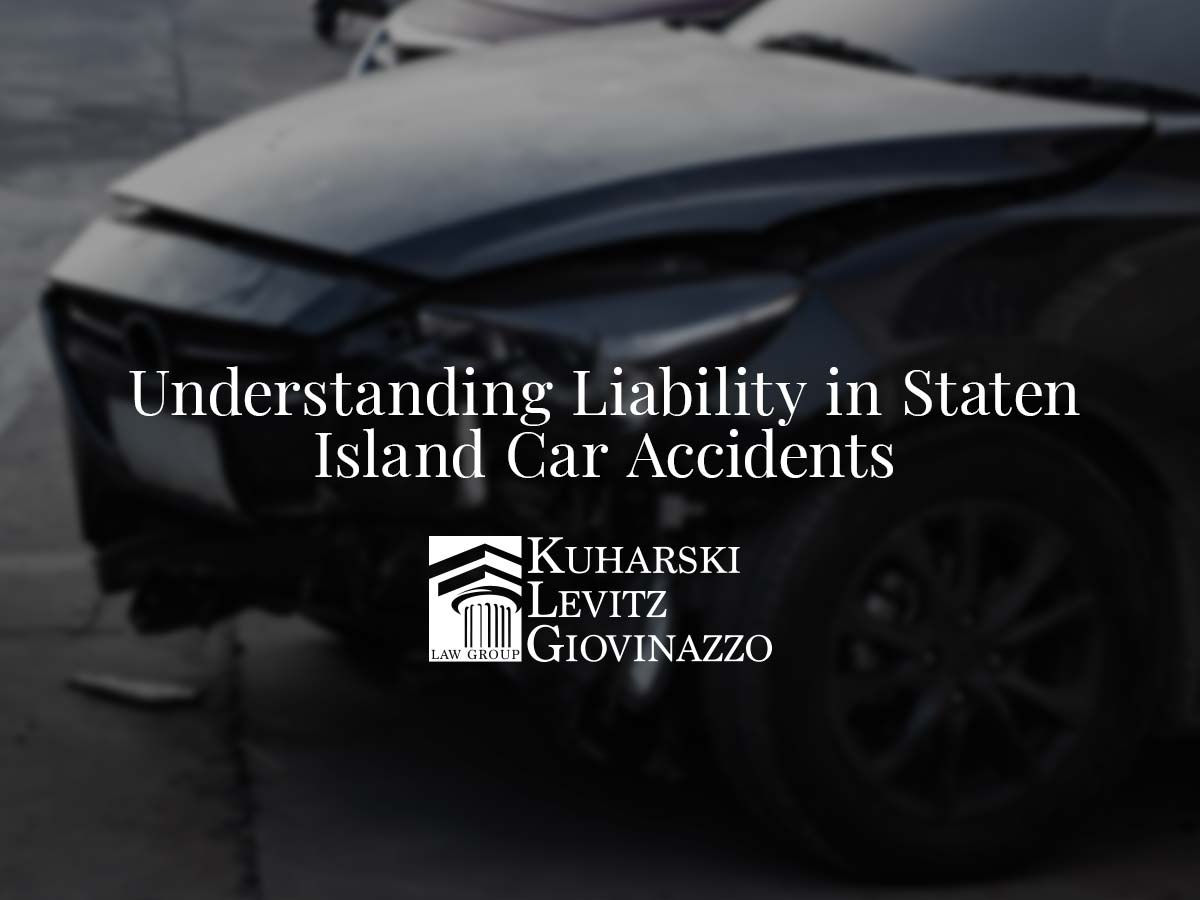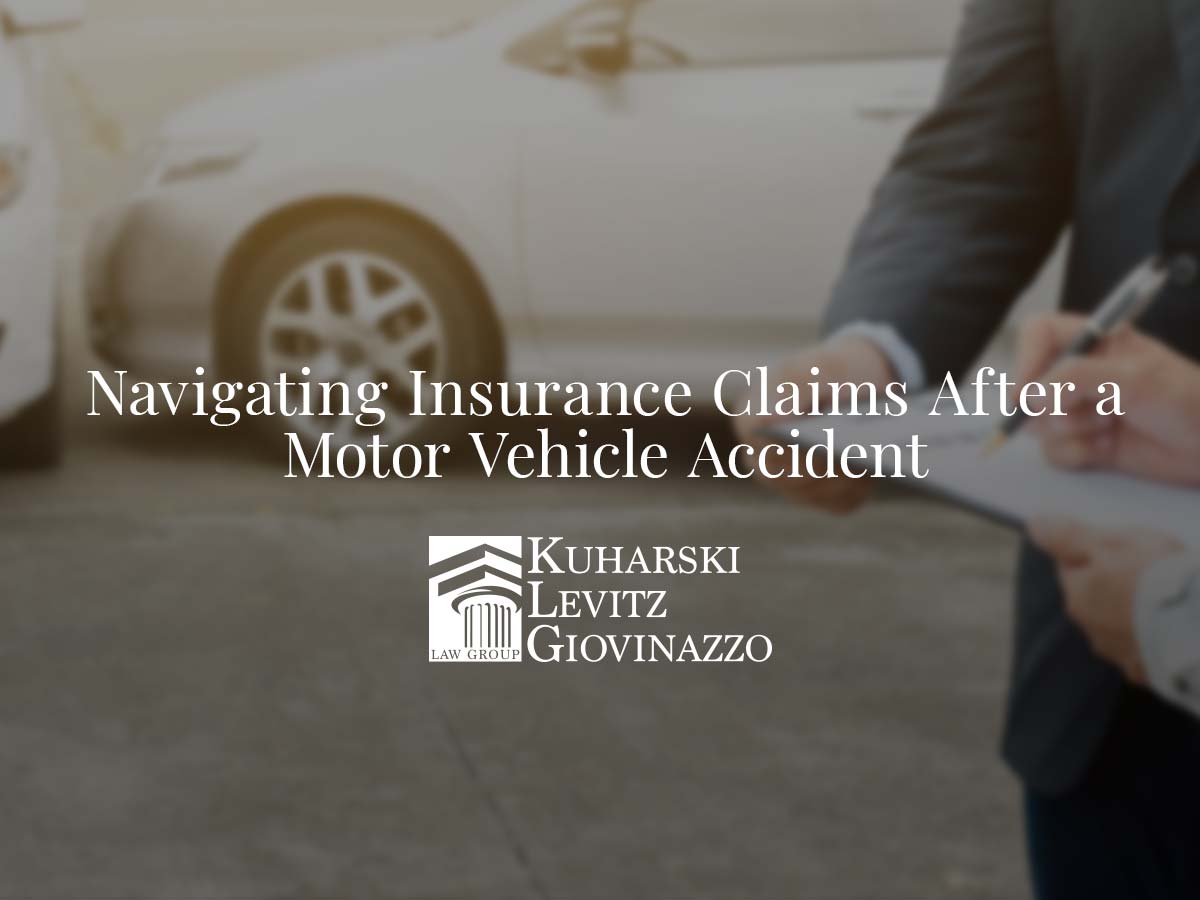After a truck accident in Staten Island, it’s crucial to understand your legal rights clearly. These rights are pivotal in shielding victims from financial strain and ensuring they can rightfully seek appropriate compensation.
Negligence frequently emerges as a critical factor in truck accident cases, underscoring the significance of having a seasoned truck accident attorney by your side.
We at Kuharski, Levitz, & Giovinazzo Law Group are a reputable firm specializing in personal injury cases, including truck accidents.
We have a team of truck accident lawyers who are well-versed in accident law and possess a deep understanding of the legal rights of victims in Staten Island. We can provide you with professional legal advice and guidance.
Our lawyers will also guide you through the legal process, ensuring your rights are always protected. If you have been involved in a truck accident in Staten Island, contacting us is in your best interest; we will help you understand your legal rights.
Common Causes of Staten Island Truck Accidents
Staten Island, a bustling borough of New York City, witnesses its fair share of truck accidents.
Here are the common causes behind these unfortunate incidents:
Driver Fatigue
One major cause is driver fatigue. Long hours on the road can lead to exhaustion for truck drivers. This tiredness often results in poor decision-making and slower reaction times.
- For instance, a report by the Federal Motor Carrier Safety Administration (FMCSA) revealed that 13% of commercial motor vehicle drivers were considered fatigued at the time of their crash.
In Staten Island, this problem is exacerbated by the heavy traffic on routes like the Staten Island Expressway.
Reckless Driving and Speeding Risks
Reckless driving and speeding are other significant factors contributing to truck accidents in Staten Island. These behaviors put the driver at risk and pose a danger to others on the road.
- The National Highway Traffic Safety Administration (NHTSA) reported that speeding fatalities increased 8% from 2020 to 2021, with 12,330 people killed in 2021 speeding-related crashes.
In densely populated areas like Staten Island, reckless driving can be devastating due to high pedestrian activity and narrow streets.
Impaired Driving Dangers
Lastly, impaired driving due to drugs or alcohol is another critical cause. Substance abuse impairs cognitive functions necessary for safe driving – such as judgment, coordination, and reaction times.
In Staten Island, this issue is particularly concerning, given the borough’s ongoing struggle with opioid addiction.
Different Types of Truck Accidents
Truck accidents encompass a variety of forms, each presenting distinct challenges and potential causes.
Here are some common types of truck accidents:
Rear-End Collisions
These accidents occur when a truck strikes a vehicle in front of it. Due to a truck’s size and weight, rear-end collisions can result in severe damage and injuries. Causes may include sudden stops, distracted driving, or inadequate braking distance.
Head-On Collisions
Head-on collisions involve a truck colliding with another vehicle from the front. These accidents are often catastrophic due to the force of impact. Factors contributing to head-on collisions include driver fatigue, impaired driving, or road conditions.
Jackknife Accidents
Jackknifing happens when the truck’s cab and trailer fold at an angle, resembling a jackknife. This can occur when the trailer swings out of control, often due to sudden braking or adverse road conditions. Jackknife accidents are challenging because they can involve multiple vehicles and complex liability issues.
Rollover Accidents
Rollover accidents occur when a truck tips over onto its side or roof. These accidents are often linked to high speeds, sharp turns, or an unbalanced load. Rollover accidents can lead to significant damage and injuries.
Blind Spot Accidents
Large trucks have substantial blind spots, areas around the truck where the driver’s vision is limited. Accidents can occur when other vehicles enter these blind spots and the truck driver is unaware of their presence. Inadequate awareness of these blind spots can lead to collisions during lane changes or turns.
Necessity of Immediate Medical Assistance
Truck accidents often result in severe injuries due to the sheer size and weight of these vehicles. Immediate medical assistance is crucial in such scenarios to ensure the survival and recovery of the victims.
Swift Attention to Injuries
After a truck accident in Staten Island, immediate medical attention can be a lifesaver. It’s not just about treating visible injuries; it’s also about assessing potential internal damage.
Many victims might feel okay at first due to the adrenaline rush, but serious injuries may lurk beneath the surface. Catastrophic injuries could have delayed symptoms, making early medical care crucial.
Role of Medical Records in Legal Claims
Medical records are solid evidence when trying to prove your injuries from the crash. They provide an unbiased account of your circumstances post-accident and can help strengthen your legal claim.
These records offer detailed information about the cause and extent of your injuries, which is invaluable for your case. A thorough medical report can make all the difference between winning and losing an injury claim.
Delayed Treatment Can Hurt Your Case
If you delay getting medical help after a truck accident, it could harm your health and legal claims. The defendant may argue that your injuries aren’t as severe as you claim or were caused by something else.
A gap in treatment gives room for doubt about whether the accident was indeed the cause of your injury. So, don’t give them any reason to question; seek immediate attention following a truck crash on Staten Island.
Follow-up care is Essential Too
Follow-up care is equally important in documenting recovery progress. Regular check-ups show that you are taking action towards healing and are not neglecting your health post-accident.
Your doctor’s notes on these visits will reflect numerous factors, like how well you’re responding to treatment or if there are any long-term effects from the accident-related injuries. This ongoing documentation provides additional evidence supporting your claim.
Role of Staten Island Truck Accident Lawyers
Staten Island truck accident lawyers are integral in helping victims navigate truck accident laws. They aid in evidence gathering, communication with insurance companies, and guiding victims throughout the claim process.
Expertise in Navigating Complex Truck Accident Laws
Staten Island truck accident lawyers are well-versed in the intricate rules and regulations surrounding truck accidents. These professionals deeply understand federal and state laws that govern commercial trucks.
For instance, they know about the Federal Motor Carrier Safety Administration (FMCSA) regulations stipulating strict standards for truck maintenance and driver hours.
Knowledge of these laws is crucial as it can impact the outcome of a case. A lawyer’s expertise helps identify all liable parties – not just the truck driver but potentially the trucking company, parts manufacturers, or other third parties.
Importance of Lawyers in Evidence Gathering
Another critical function of Staten Island truck accident lawyers is collecting and preserving evidence. This task is vital because it forms the backbone of any legal claim.
- Lawyers know what kind of evidence to look for – like skid marks, vehicle damage, CCTV footage, etc.
- They ensure this evidence is preserved correctly to prevent degradation or loss.
- If needed, lawyers can also arrange for expert witnesses to testify on your behalf.
Communicating with Insurance Companies
Dealing with insurance companies after a truck accident can be daunting. That’s where Staten Island truck accident lawyers step in.
- They handle all communications with insurance adjusters.
- Lawyers negotiate settlements on behalf of their clients.
- Their goal is to secure maximum compensation while protecting your rights.
Guiding Victims Through The Claim Process
The process following a truck accident can be overwhelming for victims. Having a knowledgeable Staten Island truck accident lawyer by your side can make this journey less stressful.
- They guide you through each step – from filing claims to negotiating settlements.
- Lawyers help you understand your legal rights and options.
- They represent you in court if a fair settlement can’t be reached.
Establishing Liability in Truck Accidents
Truck accidents can be devastating, and determining liability is critical to seeking justice and compensation for the victims. Liability in truck accidents can be complex and may involve various parties.
Here are the critical factors involved in establishing liability in truck accidents:
Driver Negligence
One of the primary factors in truck accidents is driver negligence. This can include behaviors such as speeding, distracted driving, driving under the influence, and reckless driving. Establishing that the truck driver acted negligently is crucial in holding them liable for the accident.
Trucking Company Liability
In many cases, the trucking company that employs the driver can also be held liable. If the company fails to properly maintain the truck, provide adequate training, or enforce safety regulations, they may share responsibility for the accident.
Owner and Operator Liability
If the truck is owned by one entity and operated by another, the owner and operator may be responsible for the accident. This is especially true if the owner fails to inspect and maintain the vehicle properly or the operator disregards safety protocols.
Government Liability
In some cases, government entities may share liability. Poorly maintained roads, inadequate signage, or faulty traffic signals can contribute to truck accidents. The government may be liable if the accident was caused or exacerbated by such factors.
Product Liability
If a defective part or component of the truck contributed to the accident, the manufacturer or distributor of that part may be held liable. This form of product liability requires establishing that the defective part directly caused or contributed to the accident.
Eyewitness Testimonies and Evidence
Establishing liability relies on evidence, including photographs, witness testimonies, police reports, and expert opinions. Collecting and preserving this evidence is crucial to building a solid case.
Black Box Data
Many commercial trucks are equipped with data recorders, similar to airplane black boxes. These devices can provide critical information about the truck’s speed, braking, and other factors leading to the accident.
Skid Marks and Debris
The physical evidence at the accident scene, such as skid marks and debris, can help establish the sequence of events and the actions of the parties involved.
Driver’s Log and Records
Truck drivers must maintain detailed logs of their driving hours and activities. These records can determine if the driver complied with federal regulations.
Expert Testimonies
Legal professionals, accident reconstruction specialists, and medical professionals may be called upon to provide testimonies to establish liability and demonstrate the extent of damages.
Negotiating Settlements with Insurance Companies
Dealing with insurance companies to get a fair settlement after being in a truck accident can be a complicated process. This procedure often involves complex negotiations which require a thorough knowledge of the law and insurance regulations.
We’ll guide you through the critical steps and strategies to negotiate settlements with insurance companies after a truck accident successfully.
Tactics Insurers Use to Minimize Payouts
Insurance companies are in the business of making money. They often use crafty tactics to minimize the amount they pay in settlements.
- For example, insurance adjusters might try to convince you that your injuries aren’t as serious as you claim or that you’re partly at fault for the accident.
These strategies can significantly reduce your financial compensation. It’s essential to consult a legal professional before falling for these tricks.
Consult a Lawyer Before Accepting an Offer
Many times, insurance companies will offer an initial settlement that seems generous. However, this is often just another tactic they use to avoid paying out maximum compensation.
Before accepting any offer from an insurer, it’s crucial to consult with a lawyer who specializes in truck accidents in Staten Island. They can advise on whether the settlement is fair and adequately covers your medical expenses and other damages.
Using Negotiation Skills for Fair Compensation
Negotiating with insurance companies isn’t easy. It requires skill and knowledge of how these corporations work.
A good negotiator knows how to present evidence effectively and argue convincingly for fair compensation. This includes understanding policy details and using them during negotiations.
Remember, insurers seek their bottom line, not your best interests. Therefore, having someone on your side who understands negotiation tactics can be invaluable when seeking fair compensation after a truck accident.
Understanding Policy Details
Understanding the details of an insurance policy is crucial during negotiations. These policies are often complex documents filled with legal jargon that can be difficult for laypersons to understand.
Knowing what’s covered under the policy and what isn’t can help determine whether you get a fair settlement. It can also help identify any unfair negotiation tactics that insurers use to minimize their payout amounts.
Types of Compensation in Truck Accident Case
Truck accident victims are entitled to seek various types of compensation to help them recover from the physical, emotional, and financial toll of the accident.
Here are the key types of compensation available to truck accident victims:
Medical Expenses
Truck accident victims can claim compensation for all medical expenses resulting from their injuries. This includes hospital bills, doctor’s visits, surgeries, prescription medications, rehabilitation, and other healthcare-related costs. It’s essential to keep detailed records of all medical expenses for a thorough reimbursement.
Property Damage
In a truck accident, your vehicle is likely to suffer damage. Compensation for property damage covers the repair or replacement costs of your car and any personal belongings damaged in the accident. It’s vital to document the damage through photographs and gather repair estimates.
Lost Wages
If you cannot work due to the injuries sustained in the truck accident, you can seek compensation for your lost income during your recovery. This includes the wages you’ve missed and any future earnings you may fail due to long-term or permanent disability.
Pain and Suffering
Pain and suffering compensation is designed to address the physical and emotional distress caused by the accident and your injuries. It includes not only the physical pain but also the mental anguish, emotional distress, and reduced quality of life you may experience as a result of the accident.
Punitive Damages
In some cases, punitive damages may be awarded to the victim. These are not intended to compensate for specific losses but to punish the at-fault party for egregious misconduct, such as gross negligence or intentional harm. Punitive damages are relatively rare and typically awarded in extreme misconduct cases.
Timeline for Filing Truck Accident Claims in Staten Island
In Staten Island, as in the rest of New York State, a statute of limitations sets a legal deadline for filing truck accident claims. The statute of limitations varies depending on the nature of the claim and the specific circumstances.
Here are some key points to consider:
Personal Injury Claims
If you’ve sustained injuries in a truck accident and wish to file a personal injury claim, the statute of limitations typically allows for a three-year time frame to initiate legal action. This means you generally have three years from the accident date to file a lawsuit.
Property Damage Claims
If your claim is primarily related to property damage caused by the truck accident (such as damage to your vehicle or personal property), the statute of limitations is typically three years.
Wrongful Death Claims
In the tragic event that a loved one has lost their life in a truck accident, and you intend to file a wrongful death claim, the statute of limitations is generally two years from the date of the individual’s passing.
Legal Challenges in Truck Accident Cases
Truck accident cases can be legally complex and present unique challenges that require careful navigation.
Here are some of the common legal challenges in truck accident cases:
Complexities of Evidence
Truck accident cases often involve complex evidence, including accident scene reconstruction, black box data analysis, driver logs, and witness testimonies.
Managing and presenting this evidence effectively can be challenging, and it requires a deep understanding of the technical aspects of truck accidents.
Challenges with Multiple Parties
Many truck accidents involve multiple parties, such as the truck driver, the trucking company, maintenance contractors, and even manufacturers of truck components.
Determining the extent of each party’s liability and coordinating legal actions against them can be intricate.
Insurance Disputes
Trucking companies and their insurers frequently have substantial resources and legal teams. They may contest liability and compensation claims, making it essential for the injured party to navigate potential disputes and negotiate effectively.
Prejudice and Bias
Truck accidents can evoke bias and prejudice due to stereotypes about truck drivers or the transportation industry. Overcoming any inherent biases and ensuring that the facts of the case are presented relatively is a challenge that legal professionals need to address.
Proving Negligence
Establishing negligence is a fundamental element in a truck accident case. This involves demonstrating that the at-fault party failed to exercise reasonable care, resulting in the accident and the victim’s injuries. Proving negligence can be challenging, particularly when the at-fault party disputes liability.
Importance of Legal Representation
Navigating the legal landscape after a truck accident in Staten Island can be challenging. The complexities of establishing liability, negotiating with insurance companies, and adhering to the claim filing timeline necessitate professional guidance.
Our experienced attorneys are well-versed in these matters and can provide you with the necessary representation. We understand that each case is unique, and we are committed to pursuing justice on your behalf.
Don’t let the aftermath of a truck accident overwhelm you. Call us at 1-877-274-4036 today for a consultation, and let’s explore your options together.

